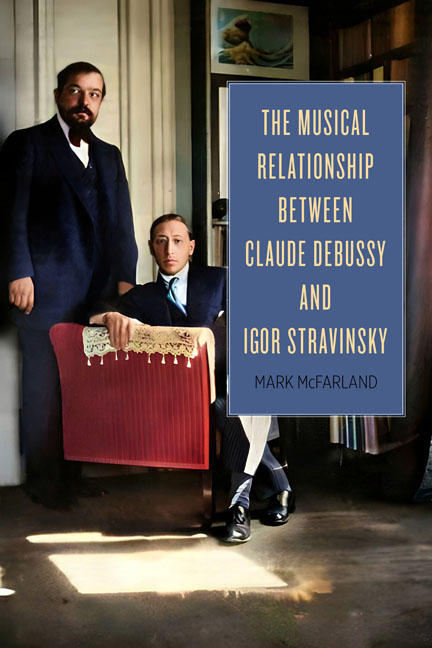Book contents
- Frontmatter
- Dedication
- Contents
- Acknowledgments
- Introduction
- 1 A Mutual Influence
- 2 Cinematic Montage and Stratified Form
- 3 Stratified Form in Debussy’s Works: 1909–1913
- 4 Debussy and the Chromatic Set
- 5 Stratified Form in Jeux
- 6 Stravinsky’s Waning Influence: 1914–1917
- Conclusion
- Glossary
- Bibliography
- Index
3 - Stratified Form in Debussy’s Works: 1909–1913
Published online by Cambridge University Press: 10 May 2024
- Frontmatter
- Dedication
- Contents
- Acknowledgments
- Introduction
- 1 A Mutual Influence
- 2 Cinematic Montage and Stratified Form
- 3 Stratified Form in Debussy’s Works: 1909–1913
- 4 Debussy and the Chromatic Set
- 5 Stratified Form in Jeux
- 6 Stravinsky’s Waning Influence: 1914–1917
- Conclusion
- Glossary
- Bibliography
- Index
Summary
“Ondine” is Debussy's most perfect realization of stratified form. The sharp disjunctions between musical events, the single scale devoted to each of the five lines, the audible synthesis between two lines as either octatonic or whole tone emerging from a diatonic setting, and the discontinuous yet similar material that forms the interlock: all these things point to a perfect fit between musical form and theoretical construct. This chapter introduces other works that are also written in stratified form and seeks to arrive at some sense of where “Ondine” fits into Debussy's output. In other words, did Debussy perceive the prelude to be a starting point from which to develop, or did it only come into being after a great deal of development had already taken place?
The dating of Debussy's works during this time clarifies this issue, but only a little. Because we will be looking in this chapter at a prelude from book 1, it is necessary to examine its dating as well as that of the second book. The first book of preludes was composed between 1907–1910. All the preludes in this book have dates of composition on them save for three, one of which is “Ce qu’a vu le vent d’ouest,” which is the one we will examine. However, Roy Howat has suggested that the date for these three undated preludes is between December 1909–January/February 1910. The composer worked on Le martyre de saint Sébastien between February and May 1911 and then went to work on the little-known ballet Khamma between December 1911 and April 1912. At the time that he began work on Khamma, Debussy also created a sketch for “Brouillards,” which makes this prelude the first to be worked on in book 2. Unlike the first book, we do not have completion dates for each of the preludes, but two works, “Les tierces alternées” and “Feux d’artifice,” were most likely finished in early January 1913, making them the last to be completed.
One feature of “Ondine” not yet mentioned was the opposition between diatonic and chromatic harmony, which is to say between tonal and post tonal elements. This extensive use of diatonic, whole-tone, and octatonic scales is perhaps the central feature of Debussy's stratified works. Indeed, each musical line in these works is generally accountable to a single collection, which clearly marks the recurrences of this line.
- Type
- Chapter
- Information
- Publisher: Boydell & BrewerPrint publication year: 2024



